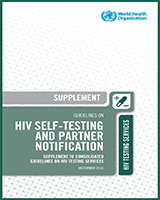Overview
Since the release of the consolidated guidelines in 2015, new evidence has emerged. Consequently, in an effort to further support countries, programme managers, health workers and other stakeholders seeking to achieve national and international HIV goals, this 2016 update issues new recommendations and additional guidance on HIV self-testing (HIVST) and assisted HIV partner notification services.
These new guidelines aim to:
Support the implementation and scale-up of ethical, effective, acceptable and evidence-based approaches to HIVST and assisted HIV partner notification.
Provide guidance on how HIVST and assisted HIV
partner notification services could be integrated into both community-based and facility-based HTS approaches and be tailored to specific population groups.
Support the introduction of HIVST as a formal HTS intervention using quality-assured products that are approved by WHO and official local and international bodies.
Position HIVST and assisted HIV
partner notification services as HTS approaches that will contribute to closing the testing gap and achieving the UN’s 90 –90 –90 and 2030 global goals.
The designations employed and the presentation of the material in this publication do not imply the expression of any opinion whatsoever on the part of the World Health Organization concerning the legal status of any country, territory, city or area or of its authorities, or concerning the delimitation of its frontiers or boundaries. Dotted lines on maps represent approximate border lines for which there may not yet be full agreement.
The mention of specific companies or of certain manufacturers' products does not imply that they are endorsed or recommended by the World Health Organization in preference to others of a similar nature that are not mentioned. Errors and omissions excepted, the names of proprietary products are distinguished by initial capital letters.
All reasonable precautions have been taken by the World Health Organization to verify the information contained in this publication. However, the published material is being distributed without warranty of any kind, either expressed or implied. The responsibility for the interpretation and use of the material lies with the reader. In no event shall the World Health Organization be liable for damages arising from its use.

